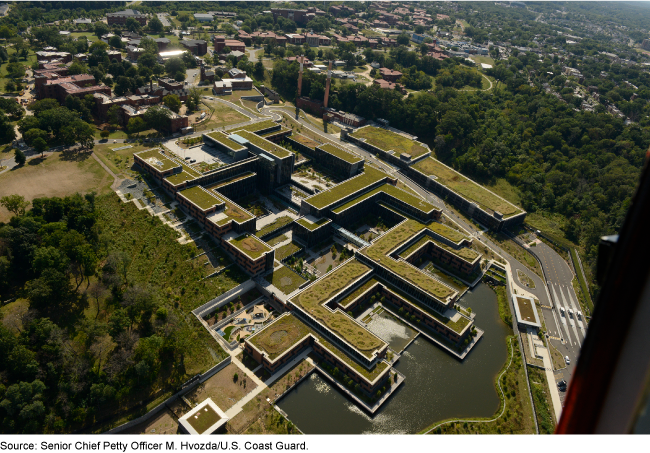Federal Buildings: Capital Access and Market Options Are Key Challenges Facing GSA's Sustainability Efforts
Fast Facts
The 8,600 buildings that the General Services Administration owns or leases for federal agencies consume a lot of energy and emit a significant amount of greenhouse gases.
In 2021, an executive order set new long-term federal sustainability goals. In response, GSA updated its practices to further promote buildings' energy efficiency and reduce their emissions—but GSA officials said it will be hard to meet these goals.
Specifically, they said that meeting the new goals will take more resources than they've had in the past. Also, more than half of GSA's regions said it's a challenge to get emissions-free electricity in their local markets.
The Coast Guard Headquarters building in Washington, DC, has an extensive green roof and other sustainable features.

Highlights
What GAO Found
Since 2006, the General Services Administration (GSA) has incorporated leading sustainability principles into its processes and practices for designing, constructing, and maintaining its buildings portfolio. In addition, GSA tests innovative building technologies and materials that enhance sustainability such as insulation that reduces heating and cooling needs. In 2011, GSA established a program to bundle multiple projects in existing buildings with the goal of reducing the buildings' energy use by at least 40 percent and making them more sustainable. Recently, in response to the December 2021 issuance of Executive Order 14057, GSA updated its standards to promote replacing existing fossil fuel systems to maximize energy efficiency and emissions reduction.
GSA has reported progress toward key sustainability goals in recent years across its buildings portfolio. From fiscal years 2018 to 2021, the share of eligible owned buildings that GSA had designated as sustainable increased from 24 to 31 percent. Over these same years, GSA reported progress in sustainability metrics to the Office of Management and Budget. GSA's aggregated buildings portfolio data show it exceeded prior goals for energy efficiency, water efficiency, emissions reduction, and renewable electricity share in fiscal year 2021.
GSA officials cited lack of access to capital as a challenge it faces in meeting future federal sustainability goals. GSA officials said the scale and scope of the projects needed to achieve net-zero building emissions by 2045 will require resources beyond what has historically been available. Officials from nearly all of GSA's 11 regions expressed little confidence in their ability to meet this goal (see figure). To address this challenge, GSA officials said the agency may need to more regularly provide upfront funding to make energy savings performance contracts economically viable. Further, these officials said they are encouraging regions to consider using Inflation Reduction Act funding, when possible.
Responses of GSA Regional Officials to GAO Questions about Federal Sustainability Goals

GSA officials also cited limited market options as a challenge in meeting future federal sustainability goals. Officials from more than half of GSA's regions told GAO that their access to carbon-free electricity is currently limited—and nearly all expressed little confidence in their ability to achieve the goal of 100 percent carbon-free electricity use by 2030 (see figure). To address this challenge, GSA has created an office to conduct market research and identify opportunities for interagency coordination on carbon-free electricity purchases.
Why GAO Did This Study
GSA owns and leases more than 371 million square feet of space in 8,600 buildings used to support federal agencies' missions. These buildings consume a significant amount of energy and are responsible for much of the federal government's greenhouse gas (such as carbon dioxide) emissions.
Since the early 2000s, laws and executive orders have established goals for GSA and other federal agencies to operate their buildings sustainably, such as by using energy and water efficiently and reducing greenhouse gas emissions. In 2021, an executive order set new long-term sustainability goals including that agencies' buildings obtain electricity from “carbon-free” sources and have “net-zero” greenhouse gas emissions. Federal law also emphasizes the use of performance contracts to deliver projects needed to advance the sustainability of federal buildings.
GAO was asked to review GSA's efforts to implement sustainability measures across its buildings portfolio. This report describes: (1) GSA's key efforts to incorporate sustainable practices; (2) GSA's recent progress toward government-wide building sustainability goals; and (3) challenges that GSA faces in meeting future government-wide sustainability goals.
GAO reviewed laws, executive orders, GSA policies, facilities standards, and sustainability plans; analyzed reports detailing GSA data for fiscal years 2018 to 2021 relative to sustainability goals; and interviewed officials from GSA's central office and each of the agency's 11 regional offices.
For more information, contact Catina Latham at (202) 512-2834 or lathamc@gao.gov.
